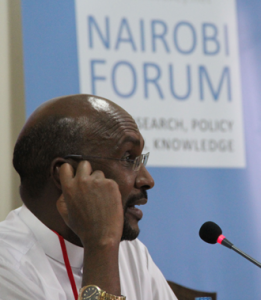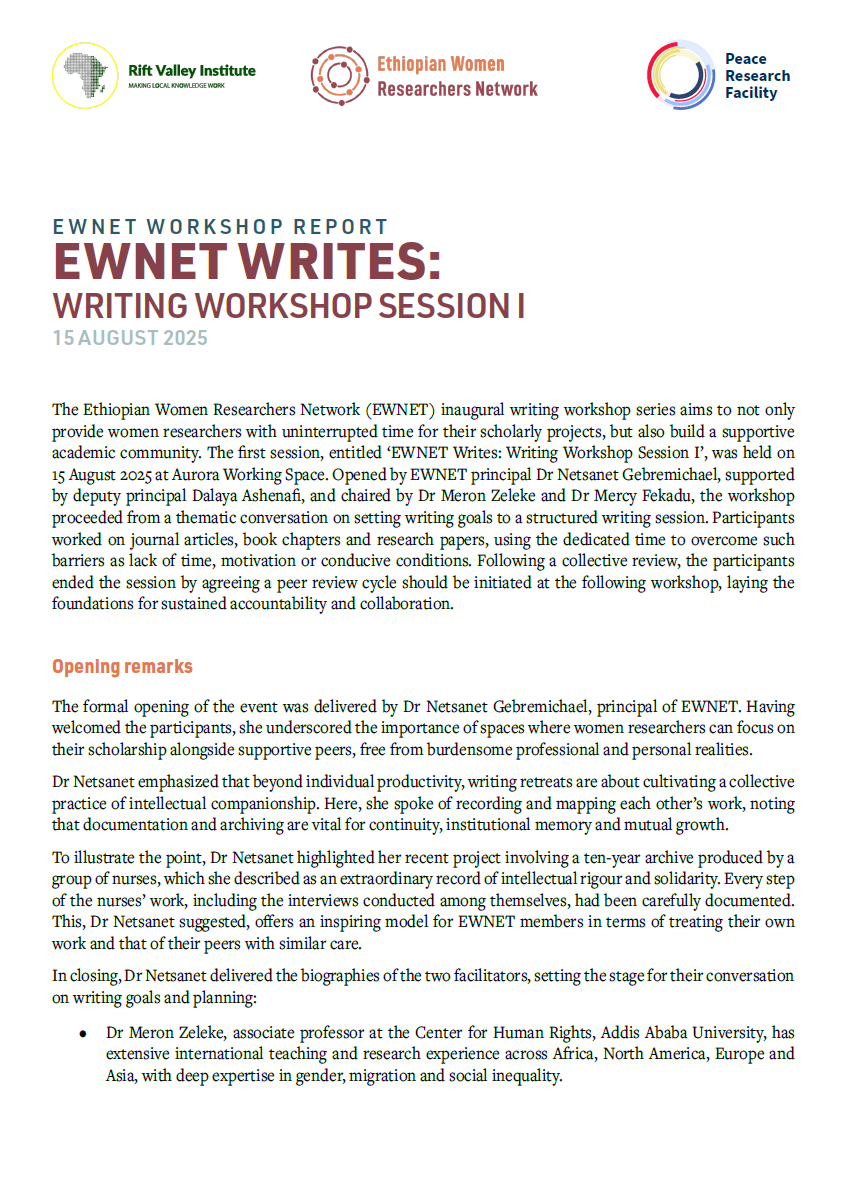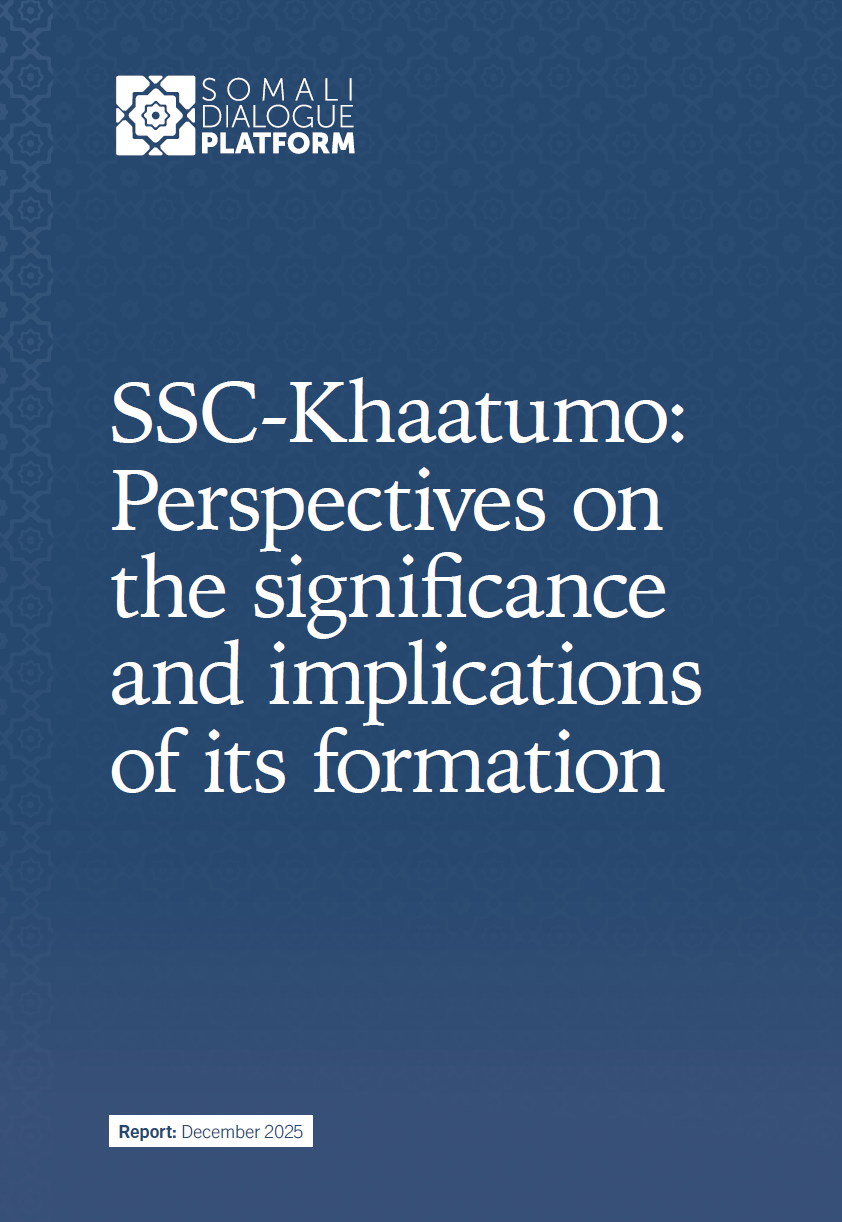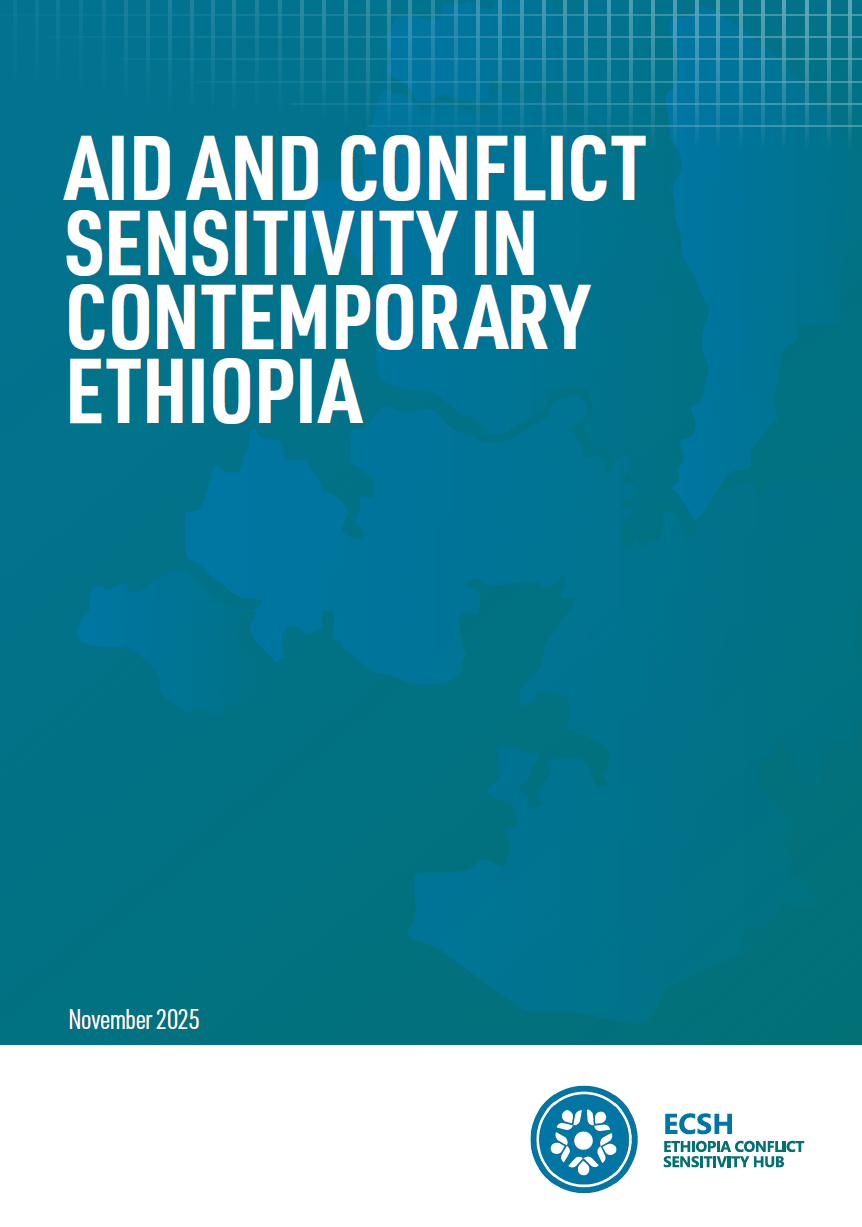Key points
-
Enormous internal innovation is taking place within pastoralist communities, challenging the perception that pastoralist communities simply cope and adapt, and revealing sustainable pathways for pastoral development.
-
Government apathy towards the pastoral economy means that Kenya, in contrast to Ethiopia, has failed to nurture, develop and benefit from the lucrative livestock trade.
-
The exploitation of the current land tenure system by commercial enterprises and foreign governments has resulted in a dramatic loss of productive land for pastoralists and farmers alike, and has generated violent conflict.
-
Applied research is needed to better understand and support pastoralist-driven innovation and sustainable development, and should be made accessible to policy makers.
-
Innovative research in pastoralism by itself will not change negative state attitudes to the pastoral economy while irrigated agriculture is prioritized.
-
Pastoralism should not be marginalized as a ‘livelihood problem’; pastoralists have the same needs as other Kenyans. Devolution offers a major opportunity for a government that is more responsive government to the needs of pastoralists and communities in Kenya’s arid and semi-arid lands.
Introductions
Ambreena Manji, Director of the British Institute in Eastern Africa (BIEA), welcomed all those attending and expressed her hope for further collaboration, particularly around issues of climate change and land use in the Horn of Africa.
Mark Bradbury, RVI Horn of Africa and East Africa Regional Director, introduced the seminar, which was organized in collaboration with the Future Agricultures Consortium (FAC). He thanked Debbie Nightingale for chairing the seminar and noted the diversity of attendees, who included representatives from government, the media, civil society, as well as various regional and international consultancies and NGOs.
Session 1
Pastoralism and Development in the Horn of Africa: Dynamic Change in the Margins
Chair: Debbie Nightingale; Speakers: Jeremy Lind (Institute of Development Studies); Hussein A. Mahmoud (Pwani University College); Abdirizak Arale Nunow (Inter-Parliamentary Union, Inter-governmental Agency on Development (IGAD)); Polly Erickson (International Livestock Research Institute), Francis Chabari (Kenya Drylands Livestock Development Programme).
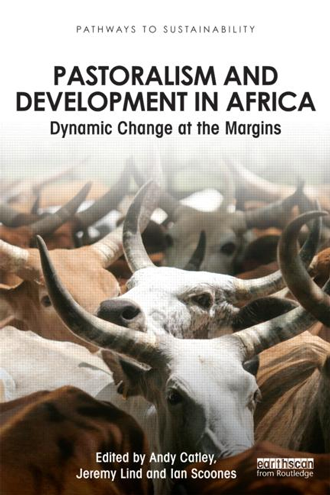 Jeremy Lind described the book’s genesis, which can be traced back to 2009 and the beginnings of a conversation among a network of African and UK-based researchers about pastoral innovation. At the time, they acknowledged a widely held fallacy that assumes any solution to the challenges faced by pastoralists, be it new technologies or knowledge, will inevitably originate from outside pastoralist communities. Contrary to this, they observed that enormous internal innovation is taking place, but that this goes largely undocumented. These researchers, in conjunction with the FAC, held a conference in 2011 in Addis Ababa, out of which the book emerged. The conference focused on understanding the nature of the opportunities and challenges posed by on-going changes to pastoralists’ access to resources, options for mobility, and potential for marketing. Over the course of the conference, contributors shared stories that emphasized cooperation and networking across borders, rather than just conflict and insecurity. They discussed examples of innovation and the emergence of new forms of businesses, which served to challenge the old adage of pastoralists simply coping and adapting.
Jeremy Lind described the book’s genesis, which can be traced back to 2009 and the beginnings of a conversation among a network of African and UK-based researchers about pastoral innovation. At the time, they acknowledged a widely held fallacy that assumes any solution to the challenges faced by pastoralists, be it new technologies or knowledge, will inevitably originate from outside pastoralist communities. Contrary to this, they observed that enormous internal innovation is taking place, but that this goes largely undocumented. These researchers, in conjunction with the FAC, held a conference in 2011 in Addis Ababa, out of which the book emerged. The conference focused on understanding the nature of the opportunities and challenges posed by on-going changes to pastoralists’ access to resources, options for mobility, and potential for marketing. Over the course of the conference, contributors shared stories that emphasized cooperation and networking across borders, rather than just conflict and insecurity. They discussed examples of innovation and the emergence of new forms of businesses, which served to challenge the old adage of pastoralists simply coping and adapting.
At the time of the conference, the news was full of reports of drought in the Horn, famine in Somalia and emergency operations in Kenya and Ethiopia. This crisis of 2010-11 brought to the fore the dire old predictions about the unviability of pastoral systems in the twenty-first century. It became apparent that a new perspective on development at the margins was needed.
In this book, the authors seek to expose and share examples of innovation, entrepreneurship and growth. Yet while some mobile herders are enjoying increased returns on their trade, others still contend with the underlying vulnerability of pastoralist systems. Lind stressed that ‘understanding and responding to this conundrum—accelerated trade and marketing and increased wealth for some, while many others become more vulnerable—is perhaps the greatest challenge we now face as a community of scholars and decision makers’.
At the book’s core then is the question: What can be done to increase returns and support those who are struggling at the margins? The book explores this in 20 detailed chapters, organised thematically around issues of resources and production; commercialization and markets; land and conflict; and alternative livelihoods. Ultimately, the case studies reveal that, in spite of the many evolving challenges facing mobile herders, there are multiple, sustainable pathways for pastoral development in the future.
Hussein Mahmoud then gave an outline of his chapter, which examines camel marketing in northern Kenya and southern Ethiopia. This borderland area holds one of the highest concentrations of livestock in Africa. He argued that focusing on the pastoral livestock trade in the Horn of Africa offers a markedly different picture to that evoked in the ‘multiple disaster’ narrative associated with the region. In his chapter, he documents encouraging trends in livestock exports to the Middle East, particularly to Egypt and Yemen via Moyale in Ethiopia.
Mahmoud stressed the significance of the camel trade, as evidenced by recent changes to the value of camels. Today a camel can fetch up to 80,000 Kenyan shillings, as compared to 10 years ago, when the market price was around 10,000 shillings. This has led to increased incomes for herders; herders switching from cattle to camels; and efforts at restocking and herd building. Combined, these developments have had a tremendous impact on regional trade.
Mahmoud went on to draw a distinction between the approaches of the Government of Ethiopia and the Government of Kenya to this trade. While Ethiopia has taken proactive steps to nurture and develop the sector, pastoralists in Kenya remain constrained by red tape and government apathy. In this regard, Ethiopia is benefitting from being at the forefront of expanding frontiers of pastoral livestock trade, and it hopes eventually to move into the field of livestock processing, rather than just marketing.
Looking forward, Mahmoud concluded by suggesting that there has not been enough examination of the effects of Kenya’s military involvement in Somalia on its livestock trade. He added that the possible re-opening of the ports of Mogadishu and Kismayo would, in all likelihood, have implications for the regional livestock trade. Perhaps fewer animals will come through Nairobi, which in turn could impact negatively on both Kenya’s share of exports and also on the supply of meat.
Abdirizak Nunow spoke about his research on land deals and the changing political economy of livelihoods in the Tana Delta. His findings were based on a study he conducted for FAC in 2011-12. Tana County has a population of roughly a quarter of a million, and is made up mainly of agricultural Pokomo and pastoral Orma. The delta is one of Kenya’s largest and most important freshwater wetland environments, and is critical for irrigation as well as for human and livestock consumption. There are many conflicting and diametrically opposed interests in the delta, which supports small-scale farmers, agro-pastoralists and hunter-gatherers.
Trust land accounts for a significant proportion of Tana County’s territory—so most people do not possess title deeds to their land and are expected to use it communally. This has been a major incentive for land grabbers, Nunow explained, who have been able to manipulate this situation to their advantage. Notable land deals in the delta first took place in 2004-5, but the rate and scale of these transactions has accelerated in the last four years. Nunow attributed this acceleration to the desire of investors to exploit the current land tenure system before the new constitution—and thus devolution—was instituted, and the National Land Commission team was gazetted. The central actors involved in recent land deals have been the Government of Kenya (through its corporate entities), private investors and foreign governments, who have acquired land for biofuel production, mineral extraction and crop production.
Nunow discussed a number of different land deals, including those involving the Tarda Mumias Partnership, Tiomin Kenya Ltd., Mat International, Bedford Biofuels and the Galole Horticulture Project. These schemes range in size from 5,000 to 93,000 hectares and are used for titanium mining, and the growing of jatropha and sugar cane for ethanol. They have affected those living in the delta in various ways, including the displacement of local communities, restriction of access to key resources, and loss of lives and livelihoods.
Nunow noted that certain local elites have taken up ranching themselves in a bid to block external land-grabbers. The violence that took place in the region in August 2012, which left 118 people dead, can be linked to the growing vulnerability of local communities, who have been rendered increasingly insecure by these dramatic changes in land ownership. This land rush is likely to continue with the proposed Lamu Port project. He concluded that there is an urgent need to quantify the economic and environmental value of the region, and to carry out an in-depth study of the impact of on-going and anticipated projects.
Polly Erickson then spoke about the work of the Technical Consortium for Building Resilience to Drought in the Horn of Africa, which aims to link demand-driven research with sustainable action for development. Funded by USAID as an 18-month project, the Technical Consortium is a joint initiative of the Consultative Group on International Agricultural Research (CGIAR) and the UN Food and Agriculture Organization (FAO). In her presentation, Erickson considered two key questions: How can such a mechanism help foster the kinds of innovation that are detailed in the book? and how can the voices of pastoralists be included in these processes?
The Technical Consortium was set up in response to the 2010-11 emergencies in the Horn, which for numerous stakeholders demonstrated that, after a decade of drought-related, a new approach was needed to prevent future disasters and build resilience to drought. This generated an interest in the idea of ‘resilience building’, but no research had been undertaken on what such initiatives might look like or how to monitor them.
For the Technical Consortium, a central focus has been on finding ways to link research to investment planning processes at a regional level. Its main aims are: firstly, to provide technical and analytical support to IGAD and its member countries in the design and implementation of Country Programming Processes and the Regional Programming Framework; secondly, to support IGAD and its members states to develop regional and national resilience-enhancing investment programmes for the long term development of arid and semi arid lands (ASALs); and thirdly, to harness research on drought resilience effectively and apply it to current investments and policies. So far, the results of the 18-month initiative have been positive. However, Erickson argued that, if its impact is to be sustained, there needs to be a second phase focused on: developing a knowledge agenda; strengthening the regional dimension; developing a flexible research and development facility; providing technical assistance; and developing ways for the sharing of knowledge and learning practices. Erickson concluded by asking what the Technical Consortium should do to enable and support pastoral driven innovation.
Francis Chabari, reflecting on the panellists’ contributions, commented that, to understand pastoralism truly, one has to have spent time living with pastoralist communities. Even then, one only begins to understand. Local knowledge is the most important factor in understanding how to build resilience. Notwithstanding this, he concluded that Pastoralism and Development in Africa is a most welcome contribution, which offers a narrative of pastoral innovation, to which policy-makers at the centre are rarely exposed.
Debbie Nightingale, the Chair, commented that from her own experience of working in conservation around issues of human and wildlife conflict, it was encouraging to hear detailed data on the importance of pastoral areas, and how much they contribute to the economy and protein consumption of Kenyans. One of the innovations she has been following closely is the creation by pastoralist communities of wildlife conservancies in southern Kenya, as a way to bring in revenue from tourism. Since 2005, 100 conservancies have been established, which include 200,000 individuals. They protect five million acres of land and last year earned $6 million of community based revenue. Nightingale considered this to be an example of innovation that holds great potential for pastoralists in Kenya, where tourism is so important for the economy. She then opened up the panel to questions from the floor.
Discussion
The Hon. Chachu Ganya (MP, North Horr), drawing on his six years experience as a parliamentarian, testified to the difficulty of trying to convince policy-makers in Nairobi to invest in the livestock trade. But, he added, this is set to change with the institution of County Governments. Hon. Ganya suggested this research can be linked with policy-makers, by creating a forum especially for parliamentarians and governors.
In response, Hussein Mahmoud agreed that the County Governments of northern Kenya were uniquely placed to tap into the export market in ways that the Government of Kenya has consistently failed to do. He recalled that livestock trading has been evolving since 1991, when many Somali pastoralists moved their herds into Kenya. But the Government has been slow to respond to this opportunity, unlike in Ethiopia, which is now re-exporting animals from neighbouring countries. Ethiopians have been very aggressive in opening up the export market and making strong and direct links with importers. The real challenge for County Governments, Mahmoud predicted, would be in devising ways to compete with Ethiopia and Sudan when Kenya’s competitive advantage diminishes with the opening up of Somalia’s ports.
One participant asked about the book’s target readership; if not pastoral communities, how can they be part of this dialogue and share in knowledge exchange? Jeremy Lind responded that the book is primarily for research and advocacy communities, and aims to document much of what is already known to pastoralist communities. The process of acquiring this information itself involved extensive consultations with these communities. Over the course of the research, Lind noted, he became increasingly aware of how juxtaposed the preoccupations of pastoralists and donors are. Pastoralists are asking themselves, ‘How can we make more wealth?’ even as donors are concerned more with how pastoralists can be made more resilient. The connections between these concerns need to be made as we move forward as a community of scholars, Lind stressed.
The key question to explore, he added, is: How does any particular model affect dynamics of wealth and poverty? If the emphasis within the whole agenda is concerned with the creation of the building blocks of wealth, there needs to be recognition and engagement with the reality that many people in this model will never receive the benefits of growth. To rely on redistribution by ‘trickle down’ or ‘trickle-out’ would be ill-judged. Instead, there must be a focus on how these people can be protected.
One participant highlighted the fact that, even after many years of innovative research into pastoralism, Kenya’s national development plan—Kenya Vision 2030—nonetheless still aspires to massive irrigation schemes. Similarly, the Jubilee Party election manifesto promised one million acres of newly irrigated land; where can this come from if not from Kenya’s rangelands? If realized, what will the impacts be of such projects on the resources that sustain pastoral communities and environments? Particular emphasis was given to the Lamu Port, Southern Sudan, Ethiopia, Transport corridor (LAPSSET), and the urgent need for research and consultative engagement with the diverse communities that will be affected by this project.
Thinking about the daily trade of camel milk from Northern Kenya to Nairobi, concern was raised by one participant over camel milk shortages as demand begins to outstrip supply. Francis Chabari suggested that there are serious innovation challenges over how to support this milk industry that has grown so quickly. Specifically, he reflected upon the rise of women’s groups in Garissa, who seek to rear camels themselves to enter this market, and asked what needs to be done to foster such participation? Mahmoud commented that today’s traders are focused on what gives the greater returns, whether this is selling camel milk or selling a live camel. Such mechanisms of profit maximisation are leading to the sorts of innovation and wealth creation described in the book.
Session 2
Lessons from the Ministry of Northern Kenya
Chair: Hon Chachu Ganya; Speaker: Hon. Mohamed Elmi
In the second session, Hon. Mohamed Elmi, MP for Tarbaj and former Minister for the Development of Northern Kenya and other Arid Lands, reflected on the work of his former Ministry, which was dedicated purely to the development of Kenya’s ASALs.
Hon. Elmi began by explaining the motives behind his forthcoming paper on the Ministry. Given that institutional memory in Kenya has tended to be poor, he argued, policies are crafted every five years with little reference to past successes and failures. He hopes that, by documenting the experiences of his Ministry, planners will be helped to respond positively to the problem of inadequate and inappropriate programming for northern Kenya.
In particular, he pointed to the uneven distribution of public investments in Kenya, which has resulted in little private sector interest in the region and its continued domination by humanitarian agencies. He used the analogy of the coffee sector to demonstrate the inadequacy and inappropriateness of government policies, noting that to produce the returns it does, the Kenyan coffee industry relies heavily on state subsidies. Moreover, rather than subsidize the livestock trade in northern Kenya, the Government currently chooses to support the growing of maize as relief food. Partly, Hon. Elmi explained, these miscalculations are due to a poor understanding of pastoral areas, rather than deliberate marginalization.
The problem of inadequate and inappropriate policies, he argued, can be traced to colonial approaches to northern Kenya and its pastoralists, which persisted after independence. Policy failures have created systemic problems of inequality, both in terms of opportunity (including access to education, healthcare, infrastructure, justice and security) and outcome (as measured by human development indices, maternal mortality rates, female literacy rates, etc.).
Perception was a problem, he acknowledged. Widespread thinking in terms of ‘the two Kenyas’ (north and south) has been an obstacle for development. Everyone needs to embrace a common Kenyan citizenship. Those living outside arid lands should try to respond to pastoralism on its own terms instead of trying to change it, while those living within arid lands should reject the narrative of marginalization.
Beyond the issue of perception, there are institutional obstacles. Under his leadership, the Ministry focused on promoting integration and working on cross-cutting issues. All the main sector ministries were pushed to mainstream ASALs into their programming, and the Ministry’s priority was to re-balance policy and institutional priorities in the long-term interest of arid lands. The difficulty in this was that incentive systems within government favour the delivery of tangible projects, not systemic change. Nonetheless, it pursued four priorities aimed at fostering systemic change: co-ordination; selective project implementation; regional interaction; and policy, legal and institutional reform. Coordination aimed to amplify the work of government. Selective project implementation involved the testing of new approaches and focusing on issues not covered by other actors. The emphasis on regional interaction sprang from the belief that pastoralists are natural pan-Africanists.
In his Ministry, considerable attention went into supporting policy, legal and institutional reforms. This effort was rewarded in the approval by parliament of an ASAL policy, after ten years of negotiations. Other outcomes achieved by the Ministry include three publications: the National Policy for the Sustainable Development of Northern Kenya; the Development Strategy for Northern Kenya and other Arid Lands; and Ending Drought Emergencies in Kenya.
Reflecting on the Ministry’s achievements, Hon. Elmi saw a tension between individuals and institutions. He acknowledged that progress in policy and institutional reform was possible only due to a network of committed individuals working both inside and outside of government. The challenge is to mainstream this agenda so that it is no longer reliant on the efforts of such individuals.
Now that a policy direction had been approved, there is need for collective and co-ordinated action to implement this. To achieve this, it will be important that arid lands are no longer viewed solely in terms of their ecology, but holistically. Pastoralism should no longer be approached as a ‘livelihood problem’; it is time that policy makers recognise that pastoralists have the same needs as all other Kenyans. Devolution offers a major opportunity for a more responsive government, though parliament remains central to ensuring the implementation of the agreed ASAL policy. The former Minister cautioned that as arid lands enter more into the spotlight, new dangers will emerge. In particular, an equitable approach to oil rich areas is essential for local communities.
Discussion
One participant asked what the Ministry had done to build capacity in ASALs in preparation for devolution. Hon. Elmi recalled a number of forums held around the country aimed at pastoralist elites. The Ministry felt that with the right civic education, pastoralist elites could be convinced of the importance of overcoming problems of ethnicity and insecurity in their areas, which would allow those resource rich counties to take off. He found it highly encouraging that the newly elected Governors of ASAL counties were amongst the most qualified and professional in Kenya. But, he added, pastoralist areas are more than just the responsibility of politicians; they require locally-based technocrats who work in government ministries to engage in efforts to make government accountable.
Closing the forum, Francis Chabari thanked Hon. Elmi, noting that his experience and reflections are vital at this time of transition. The key question is how to make this knowledge and expertise available to governors as they assume office. For counties, the issue is no longer one of resources but co-ordination. With proper planning these Counties will be able to attract investment, and ultimately to dramatically change the development trajectory of Kenya’s pastoral regions.

